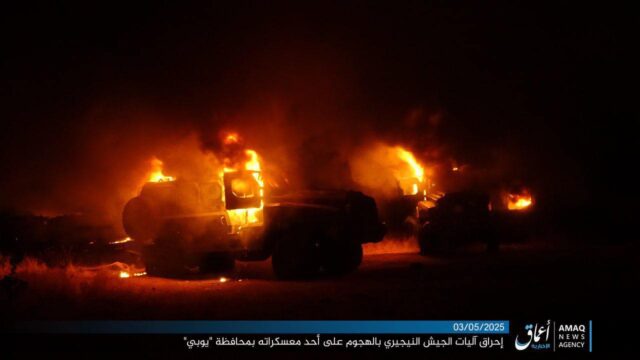
Brief: ISWAP Raids in Northeastern Nigeria Upset Regional Status Quo
Publication: Terrorism Monitor Volume: 23 Issue: 2
By:

Executive Summary:
- ISWAP has launched an unprecedented wave of raids on Nigerian military supercamps, signaling a shift in momentum and a potential end to the long-standing stalemate in northeastern Nigeria.
- The group’s recent successes—especially the May 4 Buni Gari raid—highlight its growing operational capacity and tactical innovation. New battlefield tactics, including motorcycle assaults and the use of combat drones, suggest that ISWAP is following in the steps of jihadist counterparts in the Sahel and adapting to local conditions.
Islamic State in West Africa Province (ISWAP) has attacked the Nigerian army’s heavily fortified “supercamps” an unprecedented 22 times since February. This represents an attack tempo on par with the worst Nigeria has seen since the insurgency began in 2009 and the first military bases were captured in 2013 (X/@pvanostaeyen, May 22). In the years following the launch of the Nigerian army’s “supercamps strategy” in 2019, which involved fortifying major towns harboring civilians, displaced persons, and humanitarian organizations, ISWAP has been locked in a stalemate with government forces (Vanguard [Nigeria], September 17, 2019). These large, well-defended supercamps have allowed Nigerian forces to avoid the danger of being ambushed in smaller outposts by ISWAP. The most recent string of ISWAP raids demonstrate a small, tactical evolution that could help enable ISWAP to disrupt the status quo in northeastern Nigeria and recapture a significant amount of territory.
One of ISWAP’s most devastating raids was featured in a May 4 propaganda photostream about its raid on the Buni Gari military base, which killed four soldiers. The attack occurred only a day after the North East Governors Forum met in Damaturu, Yobe State to discuss a new counter-insurgency strategy, though it is unclear whether the timing was intentional (Daily Trust [Nigeria], May 4). Taken together with the overrunning of supercamps in Goneri, Wajirko, Sabongari, Izge, and Wulgo, the Buni Gari raid highlighted that ISWAP is currently engaged in a major offensive (The Cable [Nigeria], April 8).
ISWAP uncharacteristically used motorcycle-mounted units in the Buni Gari raid. This is a noticeable shift from the heavier and sturdier 4x4s it has used to attack supercamps in the past (Daily Post [Nigeria], March 17; Facebook/Cynthia Ezeh, May 4). Motorcycles offer greater mobility in the area’s relatively flat terrain, and have been used in the past by ISWAP’s Sahelian counterpart, Islamic State in Greater Sahara (ISGS). In addition to the lighter, more maneuverable vehicle’s advantage in flat terrain, motorcycles are also easier to hide from aerial reconnaissance in areas with ground cover. Overall, the use of motorcycles in attacks suggests that ISWAP is starting to pivot toward lightning assaults, attempting to overwhelm a given supercamps’ defenses before disappearing back out into the surrounding area to avoid retaliation. This tactical evolution may ultimately be part of what breaks ISWAP’s current stalemate with Nigerian forces.
ISWAP has also recently begun to use drones for kinetic purposes, rather than for reconnaissance alone (X/@DefenseNigeria, December 28, 2024). ISWAP has employed drones in this manner since at least December 2024, when it launched a failed raid on the same Buni Gari base (Leadership [Nigeria], December 27, 2024). While such drone usage is now commonplace in armed conflicts the world over, its use by West African insurgents is significant for multiple reasons. Firstly, Nigerian government-aligned forces lack the necessary defensive equipment to combat insurgent drone attacks, such as signal jamming devices (Deutsche Welle, April 16). Secondly, the regular use of drones in attacks suggests that ISWAP has stronger supply lines than previously believed—and likely funding from Islamic States’s central apparatus (The Soufan Center, May 21). Going forward, Nigerian forces may have to place a much greater focus on cutting ISWAP supply lines to hamper their use of combat drones if they wish to overcome the group on the battlefield.
The Nigerian army is still far from winning the war against ISWAP, as it has long claimed (The New Times [Rwanda], February 5, 2018). If anything, the “stalemate” between the army and ISWAP is turning in ISWAP’s favor at the same time as al-Qaeda’s Sahelian affiliate, Group for Supporters and Islam (JNIM), is successfully seizing military bases in Burkina Faso and Mali (Times of India, June 6). While the world’s attention is hardly focused on Nigeria and the Sahel, the international community will eventually be forced to respond to the military, political, and humanitarian fallout from increasingly successful jihadist attacks in West Africa if current trends continue.



